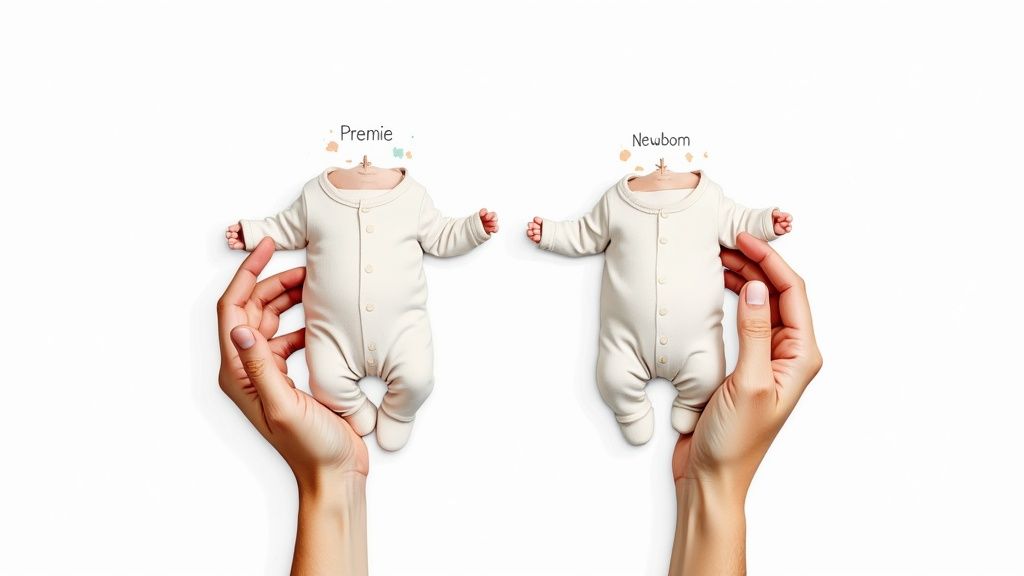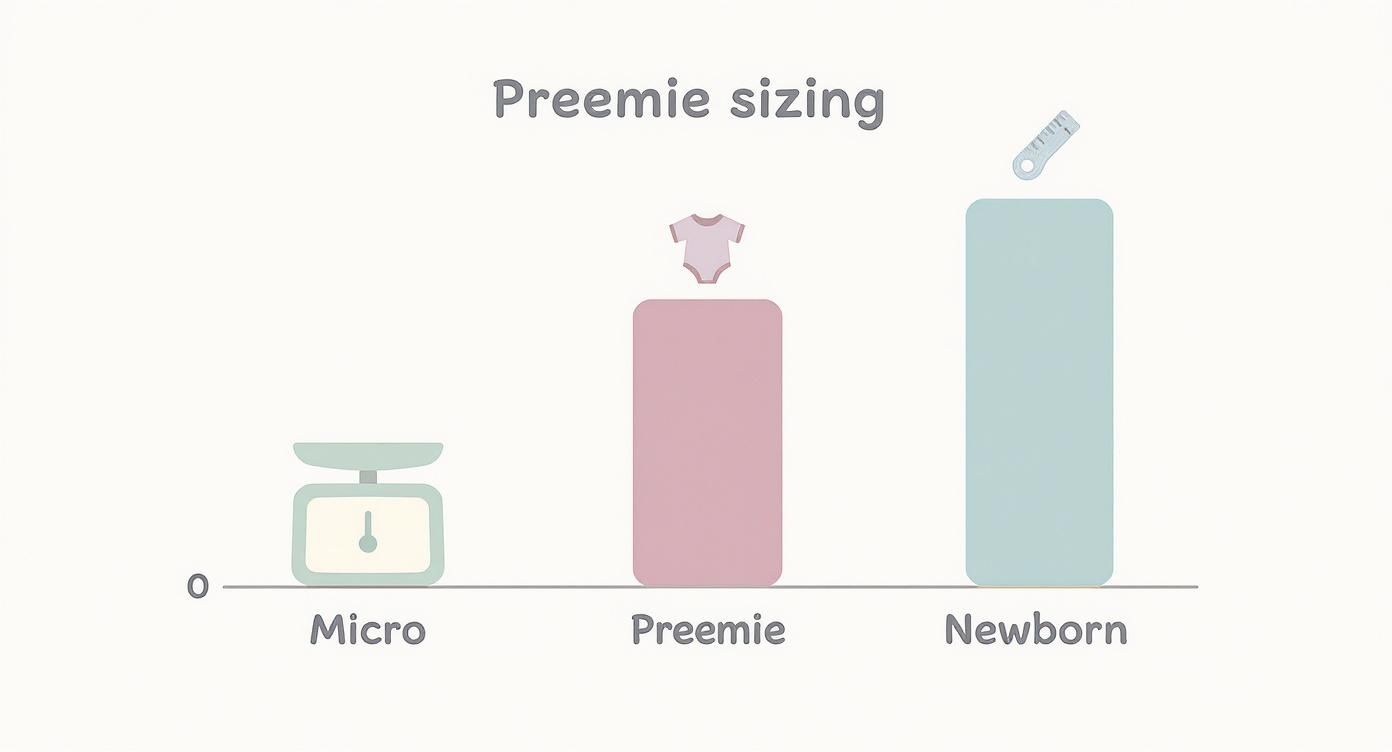Bringing your precious preemie home is a milestone filled with so much love and joy. As you step into this new chapter, a preemie clothing size chart will become your best friend. These charts are created just for babies weighing less than 5 or 6 pounds, using their unique weight and length to find a safe, snug fit that standard newborn sizes just can't offer.

Why Preemie Sizing Is So Important
Welcoming your tiny miracle home is an indescribable feeling, but let's be honest, finding clothes that fit just right can feel a little overwhelming. Standard newborn clothes often swallow up a premature baby, and a proper fit is about so much more than just looking cute—it’s absolutely vital for your baby's well-being.
The right clothing provides essential warmth and comfort for your preemie's delicate system. Here’s why paying close attention to preemie-specific sizing really matters:
-
Safety First: Clothing that's too loose, especially around the neckline, can be a serious safety risk. A snug fit means the fabric won’t ride up over your baby’s face while they sleep.
-
Essential Warmth: Preemies have very little body fat, so they need extra help staying warm. Clothes that fit properly are much better at trapping body heat, keeping your little one cozy and secure.
-
Comfort and Movement: Garments that are too big can bunch up uncomfortably, and ones that are too tight can restrict their tiny movements. Soft, well-fitting outfits let your baby rest peacefully without any fuss.
-
NICU-Friendly Features: You’ll notice many preemie clothes are designed with input from NICU nurses. They often have thoughtful features like side-snaps and open bottoms to accommodate medical lines and monitors with minimal disruption.
Your Go-To Preemie Clothing Size Chart
Trying to find clothes that fit your tiny new arrival can feel overwhelming, but it doesn't have to be. Think of this guide as your new best friend for preemie shopping—a simple, clear chart you can bookmark and pull up on your phone whenever you need it. Let's take the guesswork out of it so you can focus on the fun part.
Premature babies have a huge range in birth weight and length, often weighing anywhere from 2 to 5 pounds and measuring around 15 to 17 inches. That’s a world away from a full-term newborn. Most major brands create a standard "Preemie" size for babies up to 6 pounds and 17 inches long, but as you'll quickly learn, not all preemie sizes are created equal. You can often find children's clothing conversion charts online to see how different brands stack up.
Preemie Clothing Size Quick Reference Guide
To find the best fit, simply match your baby's current weight and length to the sizes in the table below. It’s the perfect starting point. Just remember, a size chart is a guide, not a strict rule—just like our own clothes, fits can vary a bit from one brand to the next.
This table gives you a clear look at preemie clothing sizes, breaking them down by your baby's weight and length and even giving you an idea of the garment's actual measurements.
| Size Label | Baby's Weight (lbs/kg) | Baby's Length (in/cm) | Example Garment Chest (in/cm) |
|---|---|---|---|
| Micro Preemie | Up to 3 lbs / 1.4 kg | Up to 15 in / 38 cm | 12.5 in / 32 cm |
| Small Preemie | Up to 5 lbs / 2.3 kg | Up to 17 in / 43 cm | 13.5 in / 34 cm |
| Preemie | 5 - 7 lbs / 2.3 - 3.2 kg | 17 - 18 in / 43 - 46 cm | 14.5 in / 37 cm |
| Newborn (NB) | 7 - 9 lbs / 3.2 - 4.1 kg | Up to 21.5 in / 55 cm | 15.5 in / 39 cm |
How to Get the Most Out of This Chart
Think of this chart as your home base for choosing the right size. If you find your baby’s measurements are between two different sizes, always go for the bigger one. A little extra room is much better than something tight, which can be irritating for their incredibly delicate skin.
A good rule of thumb: a slightly roomy fit is always safer and more comfortable than a snug one. Just double-check that the neckline isn't so loose that it could slip up over your baby's mouth or chin. That’s a crucial safety check for any preemie outfit.
How to Gently Measure Your Preemie for a Perfect Fit
Measuring your tiny, delicate baby can feel a bit daunting, I know. But with a gentle touch and a few simple tricks, you can get the numbers you need to find that perfect, safe fit without any fuss. Knowing your preemie’s length and chest size is the secret to making sense of any preemie clothing size chart.
First things first, create a calm, cozy space. A warm room is a must. Lay your baby down on a soft, flat surface—their changing mat is perfect for this. The whole idea is to make this a quick, stress-free moment for both of you. All you’ll need is a soft, flexible measuring tape, like the kind used for sewing.
Step-by-Step Measuring Guide
Ready? Here’s a simple, gentle way to get those all-important measurements:
- Measuring Length: With your baby lying comfortably on their back, gently straighten one of their tiny legs. Place the end of the soft measuring tape at the top of their head and carefully extend it down to their heel. That’s it—you’ve got their total length!
- Measuring Chest: Gently wrap the measuring tape under your baby's arms, bringing it across the broadest part of their chest. You want it to be flat and snug, but never tight. A good rule of thumb is that you should be able to easily slip a finger underneath it.
This quick data chart visually breaks down the sizing progression from the tiniest micro-preemie up to newborn.

As you can see, each stage represents a huge growth milestone for these little fighters. It really shows why getting those specific measurements is so important for a safe and comfortable fit.
Parent Tip: Please don't stress about getting a perfect measurement every single time. If your baby is feeling a bit wiggly, that’s totally okay! A close estimate is all you need to find the right size on the chart. Your baby’s comfort always, always comes first.
Preemie vs. Newborn Sizes: What’s the Real Difference?
Holding a tiny preemie outfit next to a "Newborn" one is a real eye-opener. The size difference is often much bigger than parents expect, which naturally leads to the question: can't I just use newborn clothes? While it seems practical, it's usually not the safest or most comfortable choice for a premature baby.
Newborn sizes are designed for full-term infants, and all that extra fabric can cause real problems for a preemie. A bodysuit that's too big can have a dangerously loose neckline, with the risk of it slipping over your baby’s mouth and nose. Likewise, sleeves and legs that are too long can easily get tangled or cover their hands and feet, which can interfere with monitoring and their sense of security.
Why the Fit Matters So Much
Think of it this way: preemie sizing is all about a snug, secure fit that feels like a gentle hug. Newborn sizing, on the other hand, is built for a baby with more body fat and a longer torso. The entire proportion is different.
Preemie-specific clothing is cut narrower through the body and has shorter arms and legs to perfectly match your baby’s delicate frame. A standard newborn sleeper, for instance, could be several inches too long for a preemie, creating uncomfortable bunching and a sloppy, unsafe fit.
"Choosing a preemie-specific size isn’t just about how it looks; it’s a crucial part of keeping your baby safe and comfortable. The right fit helps regulate their temperature and avoids the hazards that come with loose, excess fabric."
Making the Leap to Newborn Sizes
So, when is your little fighter ready to graduate? This is such an exciting milestone and a wonderful sign of how well they're growing!
Your best bet is always to consult a preemie clothing size chart, but here are the general guidelines. Most preemie sizes top out around 5 to 6 pounds, with a length of about 17-18 inches. Once your baby is consistently weighing more than that and their little outfits are starting to look a bit tight, it’s time to break out the "Newborn" size.
Newborn clothes are typically designed for babies weighing 6-9 pounds and up to 21.5 inches long. Understanding these standardized baby size progressions can give you even more confidence as you shop for your growing miracle.
Choosing the Best Fabrics and Features for Your Preemie
Once you've navigated the preemie clothing size chart, the next step is looking at the actual materials and design of the clothes. This is incredibly important. A preemie’s skin is much thinner and more sensitive than a full-term baby's, so soft, breathable fabrics are non-negotiable.
Sticking to natural fibers is one of the best things you can do for their delicate skin. Think 100% organic cotton and bamboo—these materials are wonderfully gentle, they breathe well, and they don't have the harsh chemicals that can cause irritation. They're also brilliant at helping with temperature regulation, which is a big job for a little body that can't quite manage it alone yet.
Smart Designs for Gentle Dressing
Wriggling a tiny baby into clothes can be a challenge, especially if you're in the NICU. That's why smart, adaptive clothing designs are a lifesaver for parents and so much safer and more comfortable for babies.
Here are a few key features that make a world of difference:
- Side-Snaps or Kimono-Style Bodysuits: Honestly, these are a game-changer. They open up completely flat, meaning you never have to pull anything over your baby’s head. It’s a much calmer experience for them and way less stressful for you.
- Plastic Snaps: You'll see these a lot on NICU-friendly clothing. They're preferred over metal because they don't interfere with X-rays and are gentler against a baby’s skin.
- Open-Bottom Gowns: These are perfect for those frequent diaper changes. They also give easy access for any medical lines or monitors that might be attached to your baby's feet.
The need for these practical designs really grew as NICU care advanced, pushing brands to create more specialized clothing. The result was a new wave of apparel with medical-friendly features like side openings and plastic snaps to work around monitoring equipment. You can read more about this evolution in preemie clothing on Carters.com.
A Gentle Reminder: Always, always wash new clothes before your baby wears them for the first time. A mild, fragrance-free detergent made for sensitive skin is best to get rid of any potential irritants left over from the factory.
By keeping these fabrics and features in mind, you’re not just picking an outfit—you’re wrapping your baby in comfort, safety, and a whole lot of love. For more ideas on putting together a practical wardrobe, take a peek at our essential clothes for newborns checklist.
Your Essential Preemie Clothing Safety Checklist

For your precious little one, a perfectly fitting outfit is so much more than just looking cute—it's a critical layer of safety. While our preemie clothing size chart is the best place to start, giving each outfit a quick safety check before dressing your baby offers that extra bit of priceless peace of mind.
Running through a simple mental checklist every time helps make sure your tiny fighter is always cozy and, most importantly, secure. Think of it as a final once-over to catch anything that might not be quite right. It's not about being perfect; it's about being lovingly cautious. These little checks will become second nature in no time.
The Five-Point Safety Check
Before you put on any new outfit, just take a moment to run through these five key areas. It’s super quick and makes all the difference in keeping your baby comfortable and safe.
-
The Neckline Test: This is the big one. The neckline needs to be snug enough that it cannot slip over your baby’s chin or mouth. If there's a big gap, the garment is too large and could pose a suffocation risk. Give it a gentle tug—it should stay firmly and safely below their chin.
-
Arm and Leg Openings: Have a quick look at the armholes and leg cuffs. They should be comfortably snug but never tight. A good rule of thumb is that you should be able to easily slip one finger between the fabric and your baby’s delicate skin. This ensures good circulation without being too restrictive.
-
Fabric and Seam Inspection: Run your fingers along the inside of the garment, especially along the seams. Are they flat and soft, or do they feel a bit rough? Also, check for any scratchy tags, especially around the neck area, that could irritate your baby’s ultra-sensitive skin.
-
Snap and Button Security: Gently pull on each snap, button, or any other closure. They should all feel secure and firmly attached. Loose snaps can become a choking hazard, so it’s really important to make sure they won't pop off.
-
No Excess Fabric: Make sure there isn’t a lot of extra material bunching up around your baby’s body. Too much fabric can not only be uncomfortable but could also lead to overheating. For some great tips on this, you can learn more about how to tell if your baby is too hot in our handy guide.
By making this little checklist a habit, you can dress your baby with complete confidence, knowing every outfit is like a safe, gentle hug.
Got Questions About Preemie Clothes? We’ve Got Answers.
Bringing a tiny baby home is an incredible experience, but it definitely comes with its own unique learning curve. You’re not the first parent to have these questions, and you certainly won’t be the last! We’ve gathered some of the most common things parents ask us so you can have clear, simple answers right at your fingertips.
Let's walk through them together. You've got this, and we're here to help you feel confident as you dress your little one for all those precious first moments.
How Many Preemie Outfits Do I Actually Need?
This is probably the most practical question on every preemie parent's mind! While it really depends on your laundry schedule, a good rule of thumb is to have 7-10 sleepsuits or bodysuits ready to go. Little babies are famous for spit-ups and diaper blowouts, so having at least one clean change per day (and often more) is a real sanity-saver.
Instead of buying everything in sight, focus on a small, versatile wardrobe. You'll get the most mileage out of comfy, easy-to-change pieces like side-snap onesies and open-bottom gowns that are gentle on your baby. For a complete checklist to build a smart wardrobe, our guide to newborn baby essentials is a fantastic place to start.
What Should I Look for in NICU-Friendly Clothing?
Dressing a baby in the NICU is all about function and easy access for the medical team. The right clothes can make a world of difference.
Here's what to keep an eye out for:
- Front or Side Snaps: Kimono-style tops and sleepsuits that snap all the way down the front or side are a game-changer. They let you dress your baby without pulling anything over their head, which is so much calmer for them and easier for you to navigate around any wires or tubes.
- Open Bottoms: Gowns or footless sleepers are perfect. They give nurses and doctors quick access for things like heel pricks, temperature checks, or adjusting the tiny monitoring probes on their feet.
A quick heads-up: Always chat with your NICU staff before bringing in any clothes from home. Every unit has its own rules and preferences to keep the babies safe and make sure the team can do their jobs smoothly.
Help! My Baby Is Between Sizes. What Should I Do?
It's so common for a baby to not fit perfectly into one size category—don't worry! If you find yourself stuck between two sizes on a preemie chart, the best and safest bet is always to choose the slightly larger size.
A too-tight outfit can be really uncomfortable and restrict your baby’s movement. If something is a little roomy, you can just roll up the sleeves or pant legs for a temporary fix. The most critical safety check is making sure the neckline isn't loose enough to slip up over your baby's mouth or nose.
At Mimou Babywear, we know that dressing your preemie is more than just putting on clothes—it's an act of love. Our collection of soft, breathable essentials is designed with your baby’s ultimate comfort and safety at its core, giving you gentle fabrics and practical features for every milestone.





